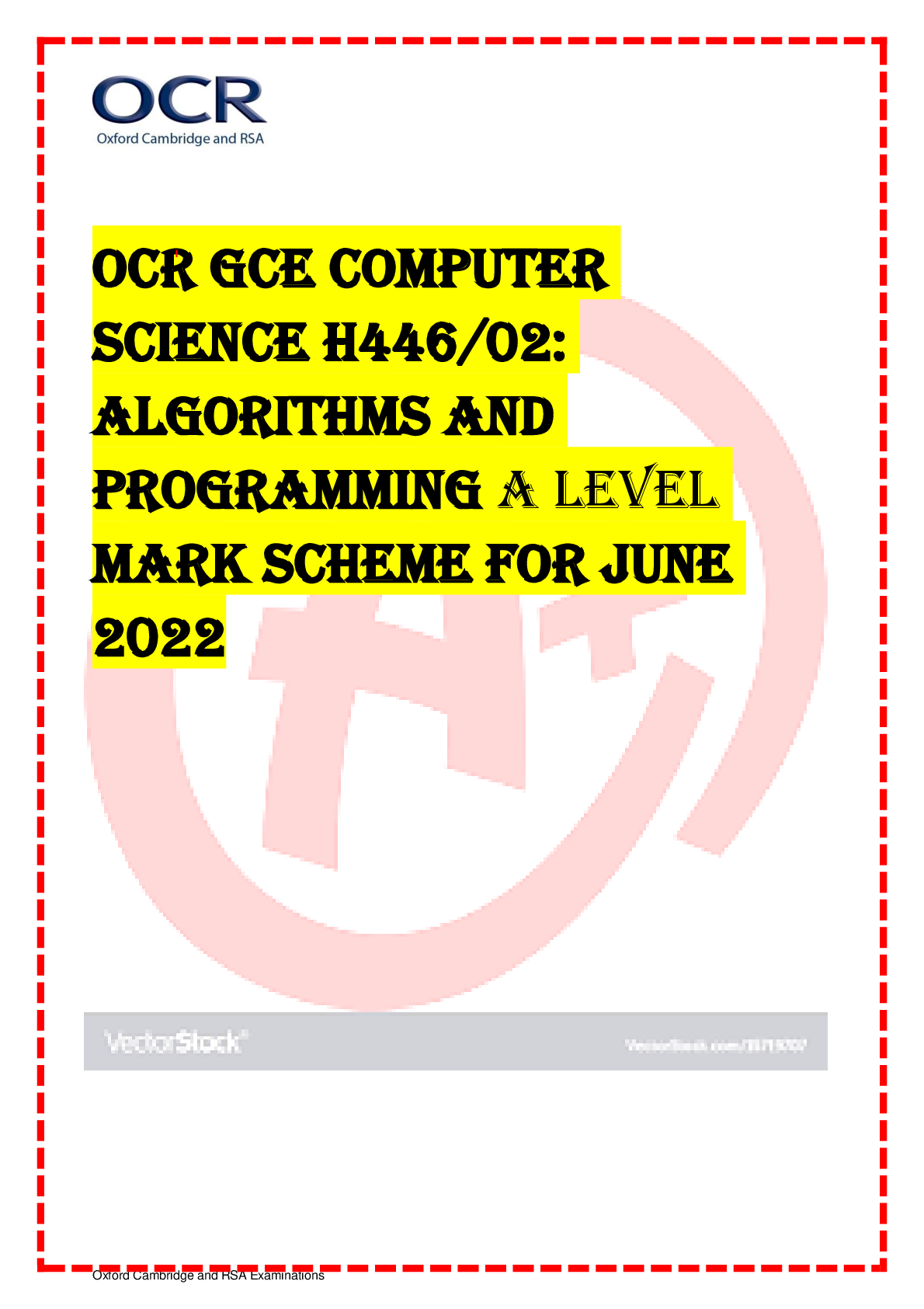Computer Science > AS Mark Scheme > GCE Computer Science H446/01: Computer systems Advanced GCE Mark Scheme for Autumn 2021 (All)
GCE Computer Science H446/01: Computer systems Advanced GCE Mark Scheme for Autumn 2021
Document Content and Description Below
Oxford Cambridge and RSA Examinations GCE Computer Science H446/01: Computer systems Advanced GCE Mark Scheme for Autumn 2021Oxford Cambridge and RSA Examinations OCR (Oxford Cambridge and RSA) ... is a leading UK awarding body, providing a wide range of qualifications to meet the needs of candidates of all ages and abilities. OCR qualifications include AS/A Levels, Diplomas, GCSEs, Cambridge Nationals, Cambridge Technicals, Functional Skills, Key Skills, Entry Level qualifications, NVQs and vocational qualifications in areas such as IT, business, languages, teaching/training, administration and secretarial skills. It is also responsible for developing new specifications to meet national requirements and the needs of students and teachers. OCR is a not-for-profit organisation; any surplus made is invested back into the establishment to help towards the development of qualifications and support, which keep pace with the changing needs of today’s society. This mark scheme is published as an aid to teachers and students, to indicate the requirements of the examination. It shows the basis on which marks were awarded by examiners. It does not indicate the details of the discussions which took place at an examiners’ meeting before marking commenced. All examiners are instructed that alternative correct answers and unexpected approaches in candidates’ scripts must be given marks that fairly reflect the relevant knowledge and skills demonstrated. Mark schemes should be read in conjunction with the published question papers and the report on the examination. © OCR 2021H446/01 Mark Scheme Annotation Meaning Omission mark Benefit of the doubt Subordinate clause / consequential error Incorrect point Expansion of a point Follow through Not answered question No benefit of doubt given Point being made Repeat Correct point Too vague Zero (big) Blank Page – this annotation must be used on all blank pages within an answer booklet (structured or unstructured) and on each page of an additional object where there is no candidate response. Level 1 Level 2 1. AnnotationsH446/01 Mark Scheme Level 3 • Subject Specific Marking Instructions Question Answer Mark Guidance 1 (a) i • Clock speed • Number of cores • Cache 2 AO1.1 Accept Use of pipelining/size of pipeline Use of out of order execution Use of SIMD instructions Integrated graphics processing on CPU ii • RAM is volatile • Used for storing programs/data/parts of OS currently in use • ROM is non volatile •• Used for storing (e.g.) BIOS / bootstrap 4 AO1.2 iii • Performing complex numerical calculations • Calculations on matrices / vectors / multiple data at the same time • …e.g. insurance pricing, modelling risk, calculating bills 2 AO2.2 Example has to relate to insurance company (b) • Concurrent processing of multiple instructions • One instruction can be fetched while previous is being decoded… • And the one before is being executed. • In case of a branch pipeline is flushed. • Increases speed of execution 3 AO1.1 (c) Mark Band 3–High Level (7-9 marks) 9 AO1 Magnetic devices include magnetic hard drives and magnetic tape.H446/01 Mark Scheme The candidate demonstrates a thorough knowledge and understanding of magnetic and solid state storage. The material is generally accurate and detailed. The candidate is able to apply their knowledge and understanding directly and consistently to the context provided. Evidence/examples will be explicitly relevant to the explanation. The candidate provides a thorough discussion which is well balanced. Evaluative comments are consistently relevant and well-considered. There is a well-developed line of reasoning which is clear and logically structured. The information presented is relevant and substantiated. Mark Band 2-Mid Level (4-6 marks) The candidate demonstrates reasonable knowledge and understanding of magnetic and solid state storage; the material is generally accurate but at times underdeveloped. The candidate is able to apply their knowledge and understanding directly to the context provided although one or two opportunities are missed. Evidence/examples are for the most part implicitly relevant to the explanation. The candidate provides a sound discussion, the majority of which is focused. Evaluative comments are for the most part appropriate, although one or two opportunities for development are missed. There is a line of reasoning presented with some structure. The information presented is in the most part relevant and supported by some evidence. Mark Band 1-Low Level (1-3 marks) AO1.1 (2), AO1.2 (2), AO2.1 (2), AO3.3. (3) Data stored by altering the magnetic field of a small section of the tape or disk; one orientation represents a binary value of 1, the opposite orientation represents a binary value of 0. Written to using a read head. Read head can then read the magnetic field and retrieve the data. These read and write heads move across the disk or the tape moves under the heads. Solid state devices store data using semiconductors; drives can be based on NAND Flash or DRAM. No moving parts are required. Backup involves copying potentially large amounts of data to and from storage devices at regular intervals. Servers distribute data to client devices. AO2 Magnetic hard drives entirely suitable for storing operating system, software and data. Large capacity, cheap (by comparison) purchasing price and reliability make them idea for heavy use in an insurance office. Solid state drives have no moving parts and offer an increase in speed and quicker access to customer records. However, smaller capacity (in comparison) may be an issue for larger data sets. Backup systems may be required to maximise storage whereas access speed is not so much of an issue Limited lifespan of SSDs due to limited read/writes may restrict use in data heavy applications. Servers will require quick access to data to serve multiple client machines but will also be extremely read/write heavy. AO3 Both suitable for the insurance office but for different purposes. SSDs to store operating system and program files will ensure quicker boot up and loading of programs. MayH446/01 Mark Scheme The candidate demonstrates a basic knowledge of magnetic and solid state storage; the material is basic and contains some inaccuracies. The candidate makes a limited attempt to apply acquired knowledge and understanding to the context provided. The candidate provides a limited discussion which is narrow in focus. Judgments if made are weak and unsubstantiated. The information is basic and communicated in an unstructured way. The information is supported by limited evidence and the relationship to the evidence may not be clear. 0 marks No attempt to answer the question or response is not worthy of credit. be useful for both client and servers to store operating systems Magnetic hard drives to store large quantities of data provides reliability and large capacity at small (by comparison) cost. May be most suitable for storing large amounts of data on client devices and for backup systems. Magnetic tape device may be suitable for backing up customer data as too slow for use on day-to-day basis. Use of solid state devices for storing customer data that is frequently accessed means needing to plan for replacement of drives when read/write limit reached. Solid state devices better if used in mobile devices (e.g. for mobile insurance workers) as relatively small chance of damage if dropped as no moving parts. (d) i • Field with a unique value • CustomerID 2 AO1.2 (1), AO2.2 (1), ii • SELECT CustomerID, Surname • FROM Customer • WHERE Title="Miss" • OR Title = "Mrs" 4 AO3.2 1 mark per bullet point. Data in fields must be in speech marks/apostrophes Allow speech mark/apostrophe FT for BP 2 and 4 Ignore colons/semicolons iii • Only one customer entry allowed (because of key field) • …so would not be able to add second entry • Customer data already present/would be repeated • ….resulting in redundant data/wasted space • …resulting in inconsistencies should changes be made 2 AO2.1 Mark in pairs. Iv • Add in second table • …for the cars // splitting up cars/customers • The primary key of customer is used as a field in the car/vehicle table • … as a foreign key of cars • Create one to many relationship. Accept many to one. 5 AO1.2H446/01 Mark Scheme Question Answer Mark Guidance 2 (a) i 11100111 1 AO1.2 ii 0110 1111 1 AO1.2 (b) i • Move decimal place 1 place right = 0.1101 to normalise • Pad with 0s, mantissa is 011010 • Exponent is 4 / Subtract 1 from exponent… • New exponent is 3 = 0011 4 AO1.2 ii • move dp 3 places right • 0110.1 • 6.5 3 AO1.2 Accept conversion of un-normalised number (will result in same output) Accept method of using 0.1101 x 2^3 FT required from part (i) if this is done incorrectly. (c) • Calculating exponent of 6 for first number/Calculating exponent of 4 for second number • Moving binary point correct number of places in both mantissa to give 0110000.0 and 01010.0 • Addition of 0110000.0 and 01010.0 to give 0111010.0 • Movement of binary point six places to left to match original mantissa format and give value of 011101 • Calculate exponent in original format to give value of 0110 5 AO1.2 Alternative: • Calculation of exponents (6 and 4) // difference between exponents of 2 • Move first mantissa 2 places left // second mantissa 2 places right to match exponents • …giving 011.000 + 0.10100 (exp 4) // 0.11000 + 0.00101 (exp 6) • Correct addition (answer of 011.1010 // 0.111010) • Final answer normalised (011101 exp 6) If exponents initially matched to 4, final bullet point should only be given if answer is normalised. If exponents matched to 6, answer will already be normalised. Ensure that answer is in format described (6 bits for mantissa 4 bits for exponent) to gain final bullet point.H446/01 Mark Scheme Question Answer Mark Guidance 3 (a) • HTML defines the structure of a web page • HTML defines the content of a web page • Using tags (enclosed in <>) • CSS defines the style / appearance • Using selectors such as classes / IDs / etc • Can be placed within HTML or externally in a file • Multiple pieces of CSS can be combined (the more local instances overriding) 4 AO1.1 Do not accept layout/format for HTML as this is too vague and can be used to describe CSS (b) • Correct <a> with close • href property to correct page • correct <img> tag with src property to correct file 3 AO3.2 <a href=”booking.htm”><img src=”ticket.png”></a> (c) • 2.99 • nonUKprice • numtickets • return 4 AO3.2 Correct answer only. Penalise spelling if incorrect. Do not accept £ sign in first bullet point. (d) i • processing done away from the user’s control/Client side processing could be altered • Browser may not support client-side language/ scripting could be turned off • Booking fee calculation needs to be correct for all locations 3 AO2.1 ii To the customer any 2x1: • No need to submit to server and wait for response 2 AO1.2H446/01 Mark Scheme • Website will work more quickly for user To the company any 2x1: • Reduces load on the server • Will need to spend less on processing power/bandwidth (e) i • Web crawler /spider visits site • Either be selecting it from an existing list or following a link. • Records information • …such as text / metatags / etc • Records the position of each word within the page • Storing them in an index • Follows links to other sites • Robots.txt file can be used to instruct web crawlers 4 AO1.1 ii • A value between 0 and 1 • Probability that a user will not follow a link 1 AO1.1 iii • Number of links to target site • PageRank score of those sites (linking inwards) 2 AO1.1H446/01 Mark Scheme Question Answer Mark Guidance 4 (a) Mark Band 3–High Level (7-9 marks) The candidate demonstrates a thorough knowledge and understanding of legislation including the Computer Misuse Act. The material is generally accurate and detailed. The candidate is able to apply their knowledge and understanding directly and consistently to the context provided. Evidence/examples will be explicitly relevant to the explanation. The candidate provides a thorough discussion which is well balanced. Evaluative comments are consistently relevant and well-considered. There is a well-developed line of reasoning which is clear and logically structured. The information presented is relevant and substantiated. Mark Band 2-Mid Level (4-6 marks) The candidate demonstrates reasonable knowledge and understanding legislation including the Computer Misuse Act; the material is generally accurate but at times underdeveloped. The candidate is able to apply their knowledge and understanding directly to the context provided although one or two opportunities are missed. Evidence/examples are for the most part implicitly relevant to the explanation. The candidate provides a sound discussion, the majority of which is focused. Evaluative comments are for the most part appropriate, although one or two opportunities for development are missed. 9 AO1.1 (2), AO1.2 (2), AO2.1 (2), AO3.3. (3) AO1 Computer Misuse Act is legislation aimed at criminalising unauthorised access to a computer system Three stages: Unauthorised access to a computer system Unauthorised access with intent to commit further offences Unauthorised modification of computer material Punishable by up to twelve months in prison and an unlimited fine. AO2 Computer users who investigate how systems work require authorisation in order to not break the Act. Examples such as changing a social media post on a friend’s mobile phone potentially breaks all three sections of the Act. Investigation of systems can break the Act without intent, e.g. by changing server logs because of their actions. Users must be aware of the Act (as with any other law) in order to be responsible. AO3 Material available online (e.g. self study videos) that explain how systems work and teach without the need to investigate using unauthorised access. Investigating systems that you own yourself or have authorisation to access does not break the law. Systems are offered to users with strict conditions attached and investigation is not a legitimate excuse for breaking the law. Ethical / white hat hackers will not break this law because they have authorisation. Grey and black hat hackers will break Computer Misuse Act.H446/01 Mark Scheme There is a line of reasoning presented with some structure. The information presented is in the most part relevant and supported by some evidence. Mark Band 1-Low Level (1-3 marks) The candidate demonstrates a basic knowledge of legislation including the Computer Misuse Act; the material is basic and contains some inaccuracies. The candidate makes a limited attempt to apply acquired knowledge and understanding to the context provided. The candidate provides a limited discussion which is narrow in focus. Judgments if made are weak and unsubstantiated. The information is basic and communicated in an unstructured way. The information is supported by limited evidence and the relationship to the evidence may not be clear. 0 marks No attempt to answer the question or response is not worthy of credit.H446/01 Mark Scheme Question Answer Mark Guidance 5 (a) Q ≡ A ∧ B ∧ (C ∨ D) 3 AO1.2 Q ≡ A ∧ B ∧ (C ∨ D) Accept alternative symbols for AND / OR e.g. Q = A AND B AND (C OR D) Brackets must be included for 3rd point Allow XOR for bullet point 3 Any additional symbols max 2 marks (b) i • Identification of De Morgan’s and/or double negation rule • Correct final answer to give A v B 2 AO2.2 (c) i S = A ⊻ B C = A ∧ B 2 AO2.1 Accept alternative symbols for AND /XOR ii • 1 mark for S column • 1 mark for C column 2 AO2.1 A B S C 0 0 0 0 0 1 1 0 1 0 1 0 1 1 0 1 iii • Logic circuit adds together 2 binary digits / half adder 4H446/01 Mark Scheme • S gives sum, C gives carry • Two half adders can be joined together… • …with an OR gate • to form full adder • 4 full adders can be used to add two four bit numbers • Carry out on one joined to carry in on next AO1.2H446/01 Mark Scheme Question Answer Mark Guidance 6 (a) i • Temporary storage/memory location… • …inside the CPU • Used for a single specific purpose • Faster access speed than RAM / secondary storage 2 AO1.1 ii • Accumulator checked to see if value held is positive or zero • If so, BRANCH carried out / jumps to specified location. 2 AO1.2 (b) • 2, 2 • 9,0 • 4,0 • 0,3 4 AO2.2 Code finds integer division and remainder. (c) • Input two numbers into two separate variables / other suitable data structure • Correctly calculate integer division • Correctly calculate remainder • Print out both 4 AO3.2 Can be completed either by using MOD / DIV or by using repeated subtraction as in LMC example (d) Mark Band 3–High Level (9-12 marks) The candidate demonstrates a thorough knowledge and understanding of different modes of addressing. The material is generally accurate and detailed. The candidate is able to apply their knowledge and understanding directly and consistently to the context provided. Evidence/examples will be explicitly relevant to the explanation. 12 AO1.1 (2), AO1.2 (2), AO2.1 (3), AO3.3. (5) AO1 Immediate addressing is where the operand holds the actual data to be used; no address referenced Direct addressing is where the operand holds the address that holds the data to be used. Indirect addressing is where the operand holds an address which is where the data to be used is stored Indexed addressing is where the operand holds an address which is offset using the Index Register to find the true address of the data to be used AO2H446/01 Mark Scheme The candidate provides a thorough discussion which is well balanced. Evaluative comments are consistently relevant and well-considered. There is a well-developed line of reasoning which is clear and logically structured. The information presented is relevant and substantiated. Mark Band 2-Mid Level (5-8 marks) The candidate demonstrates reasonable knowledge and understanding of different modes of addressing; the material is generally accurate but at times underdeveloped. The candidate is able to apply their knowledge and understanding directly to the context provided although one or two opportunities are missed. Evidence/examples are for the most part implicitly relevant to the explanation. The candidate provides a sound discussion, the majority of which is focused. Evaluative comments are for the most part appropriate, although one or two opportunities for development are missed. There is a line of reasoning presented with some structure. The information presented is in the most part relevant and supported by some evidence. Mark Band 1-Low Level (1-4 marks) The candidate demonstrates a basic knowledge of different modes of addressing; the material is basic and contains some inaccuracies. The candidate makes a limited attempt to apply acquired knowledge and understanding to the context provided. The candidate provides a limited discussion which is narrow in focus. Judgments if made are weak and unsubstantiated. The information is basic and Immediate addressing; operand of 27 would refer to the value 27 Direct addressing; operand of 27 would tell the processor to fetch the data held at address 27. Indirect addressing; operand of 27 would tell the processor to fetch the data held at address 27, which itself would then be used an address to fetch data from. Indexed addressing; operand of 27 would be added to the value of the Index register and this would then be used as the address to fetch data from. AO3 Immediate addressing allows simple access to data with no fetch required, but limited by the data size of the operand. Direct addressing allows data to be fetched from memory. Data can potentially be larger in size that with immediate addressing but address range limited by size of operand. Indirect addressing allows a larger range of addresses to be accessed as address fetched. However, multiple fetches required to access data. Indexed addressing allows the Index register to be manipulated to access data stored sequentially e.g. in an array.H446/01 Mark Scheme communicated in an unstructured way. The information is supported by limited evidence and the relationship to the evidence may not be clear. 0 marks No attempt to answer the question or response is not worthy of credit.H446/01 Mark Scheme Question Answer Mark Guidance 7 (a) (i) Stack 1 AO1.1 Correct answer only (ii) • Input name from user • Check if stack is full e.g.(top <=5) • If not, update top pointer • Correctly push name to index referenced by top 4 AO3.2 Example answer new = input("enter a name : ") if top <=5 then top = top + 1 wNames[top] = new end if (b) 1 mark per name inserted in correct place in diagram 4 AO2.1 (ii) • Compare with Kirstie – Zoe is larger so go right • Compare with Martyn - Zoe is larger so go right • No right element so stop/not found 3 AO2.2 Allow FT from b(i) (iii) • Binary tree more efficient than linked list • Do not need to check every value / tree removes half values each time 2 AO1.2 Allow reference to big O for second mark. Linked List O(n), Binary Tree O(log n) (iv) • Binary tree less efficient than hash table • Hash table can find data immediately / without checking other values. 2 AO1.2 Allow reference to big O for second mark. Binary tree O(log n) Hash table O(1) (c) (i) • Object – instantiated from class • Method – action object performs / link to procedure/functions • Attribute – value held by object / link to variable 3 AO1.1 (ii) • Class definition statement • Defining name and attendance attributes 5 One mark per bullet point to 5 maximum.H446/01 Mark Scheme • Appropriate get methods for name and attendance that return a value and have no parameter • Appropriate set methods for name and attendance that take a parameter • …that restricts attendance to be 0 to 100. AO3.2 Example answer class Customer private name private attendance public function getName() return name end function public function getAttendance() return attendance end function public procedure setName(newName) name = newName end procedure public procedure setAttendance(newAttend) if newAttend >=0 and newAttend <=100 then attendance = newAttend end if end procedure end classOCR (Oxford Cambridge and RSA Examinations) The Triangle Building Shaftesbury Road Cambridge CB2 8EA [Show More]
Last updated: 1 year ago
Preview 1 out of 19 pages
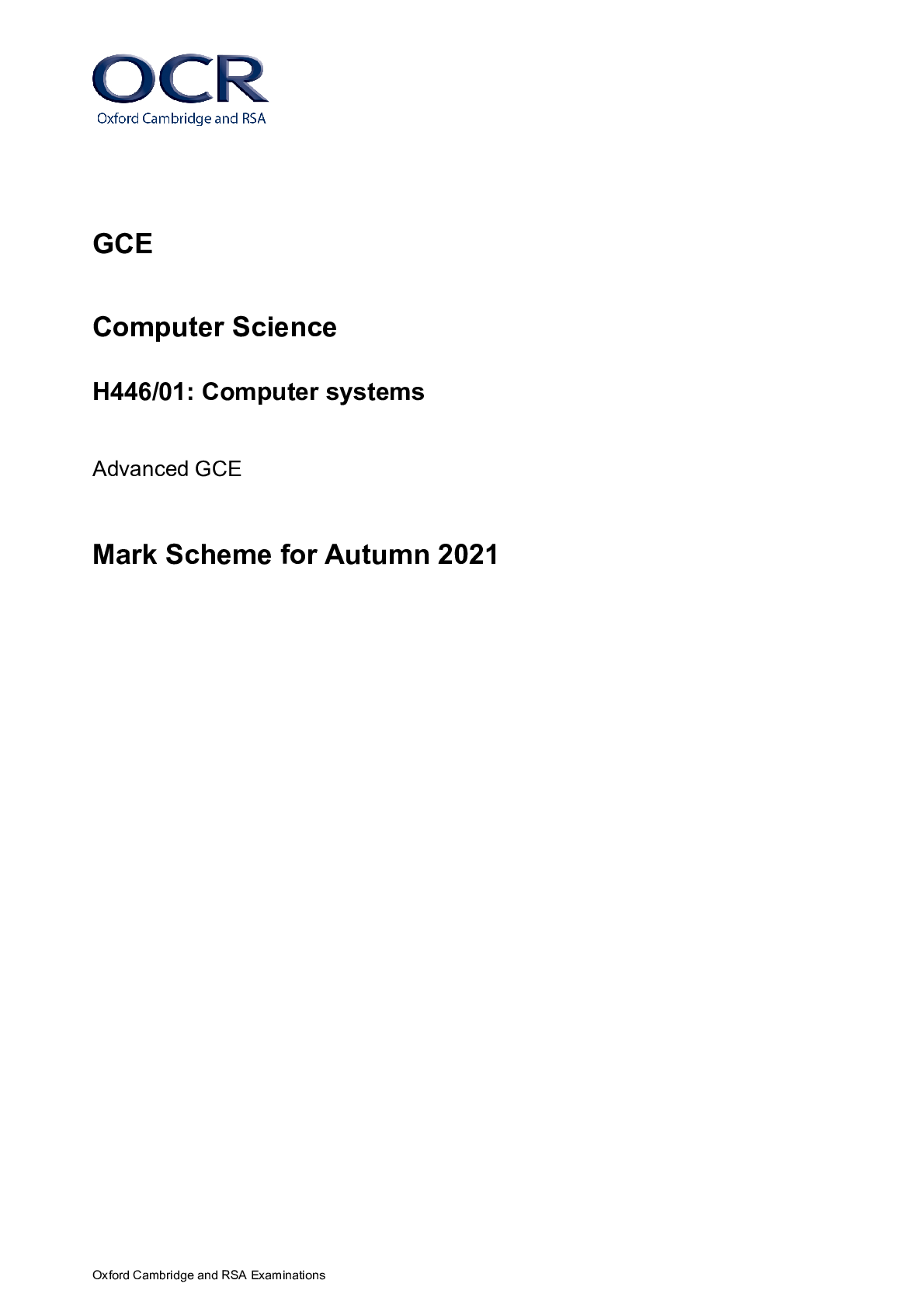
Reviews( 0 )
Document information
Connected school, study & course
About the document
Uploaded On
Oct 10, 2022
Number of pages
19
Written in
Additional information
This document has been written for:
Uploaded
Oct 10, 2022
Downloads
0
Views
62








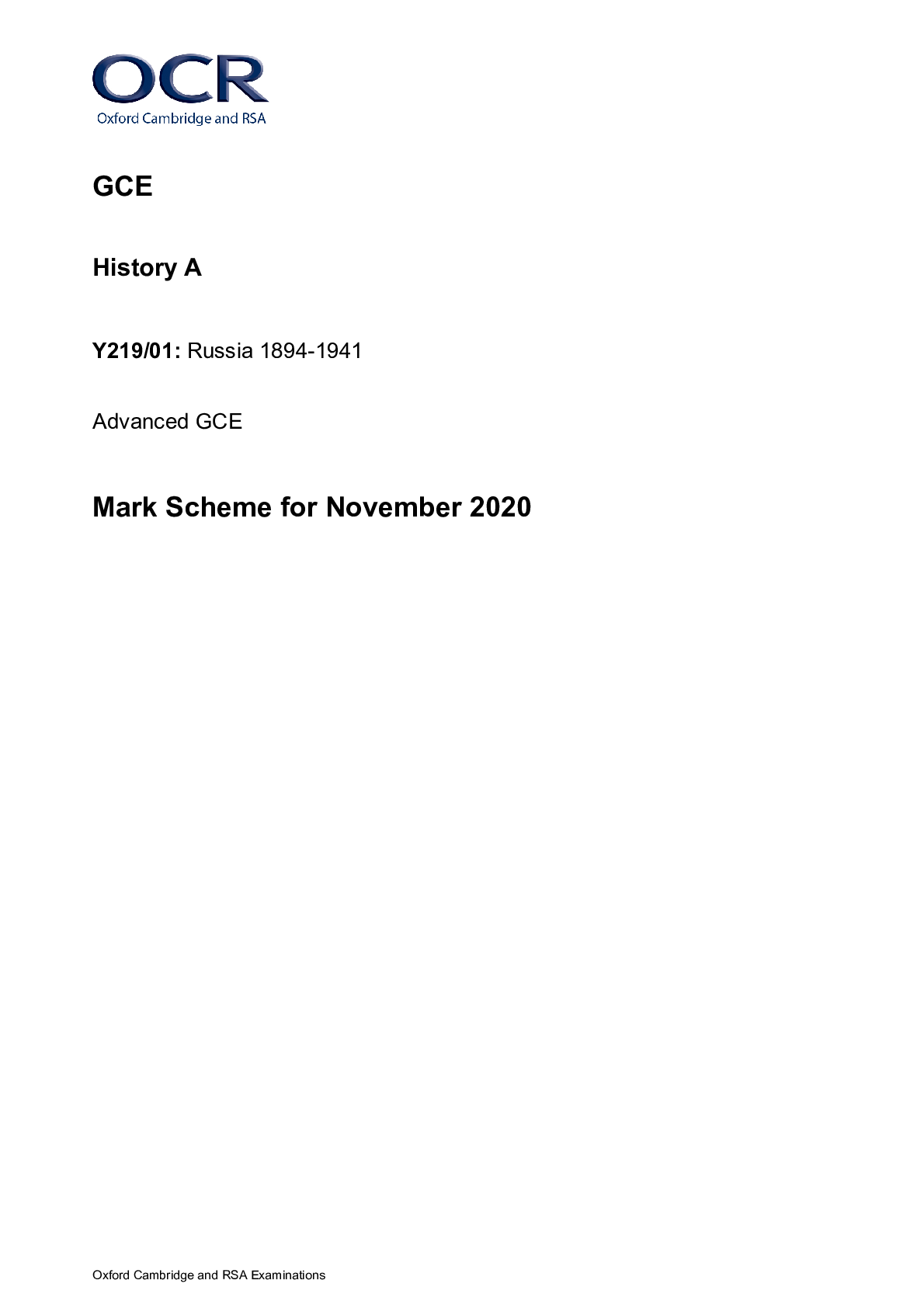
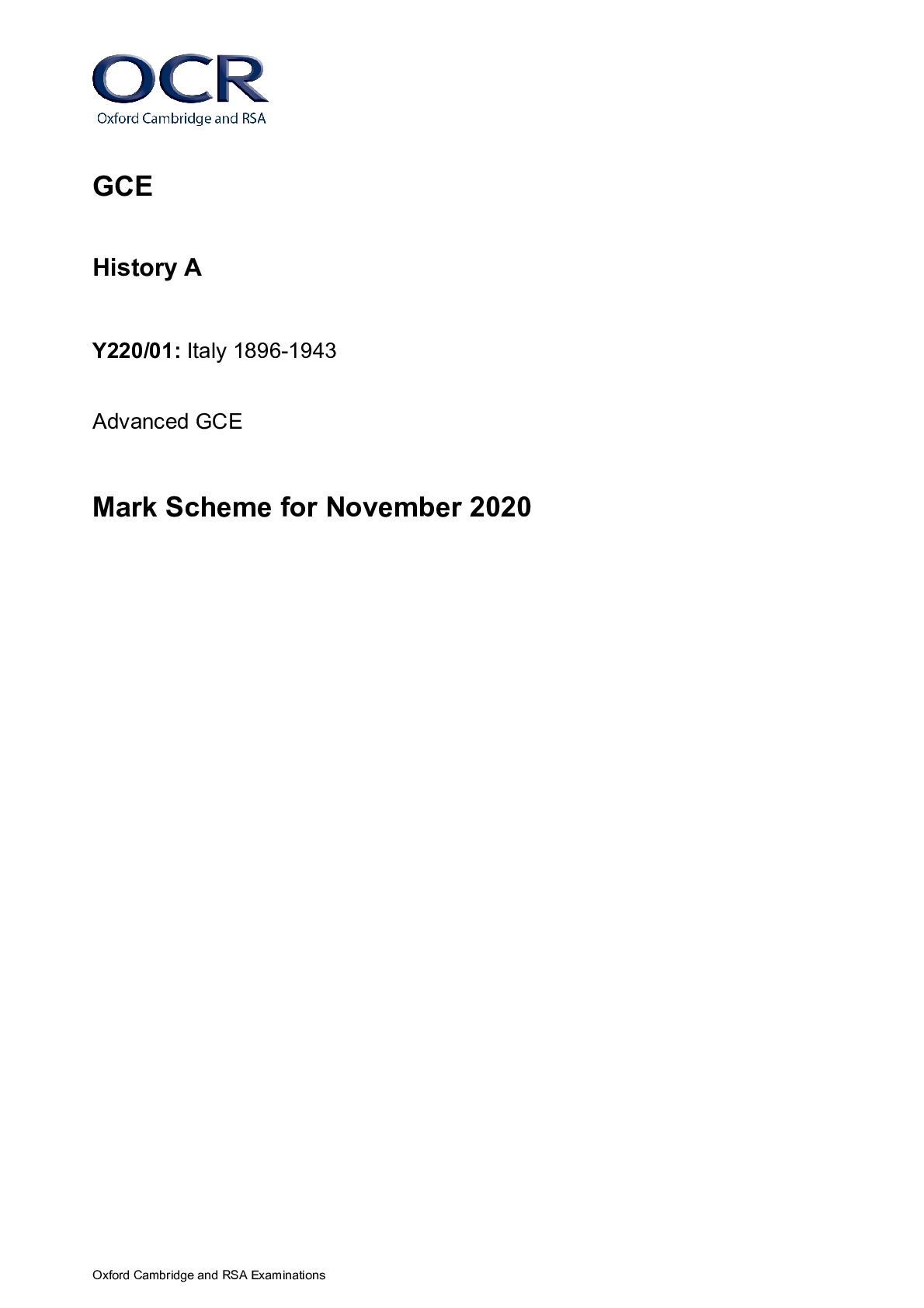

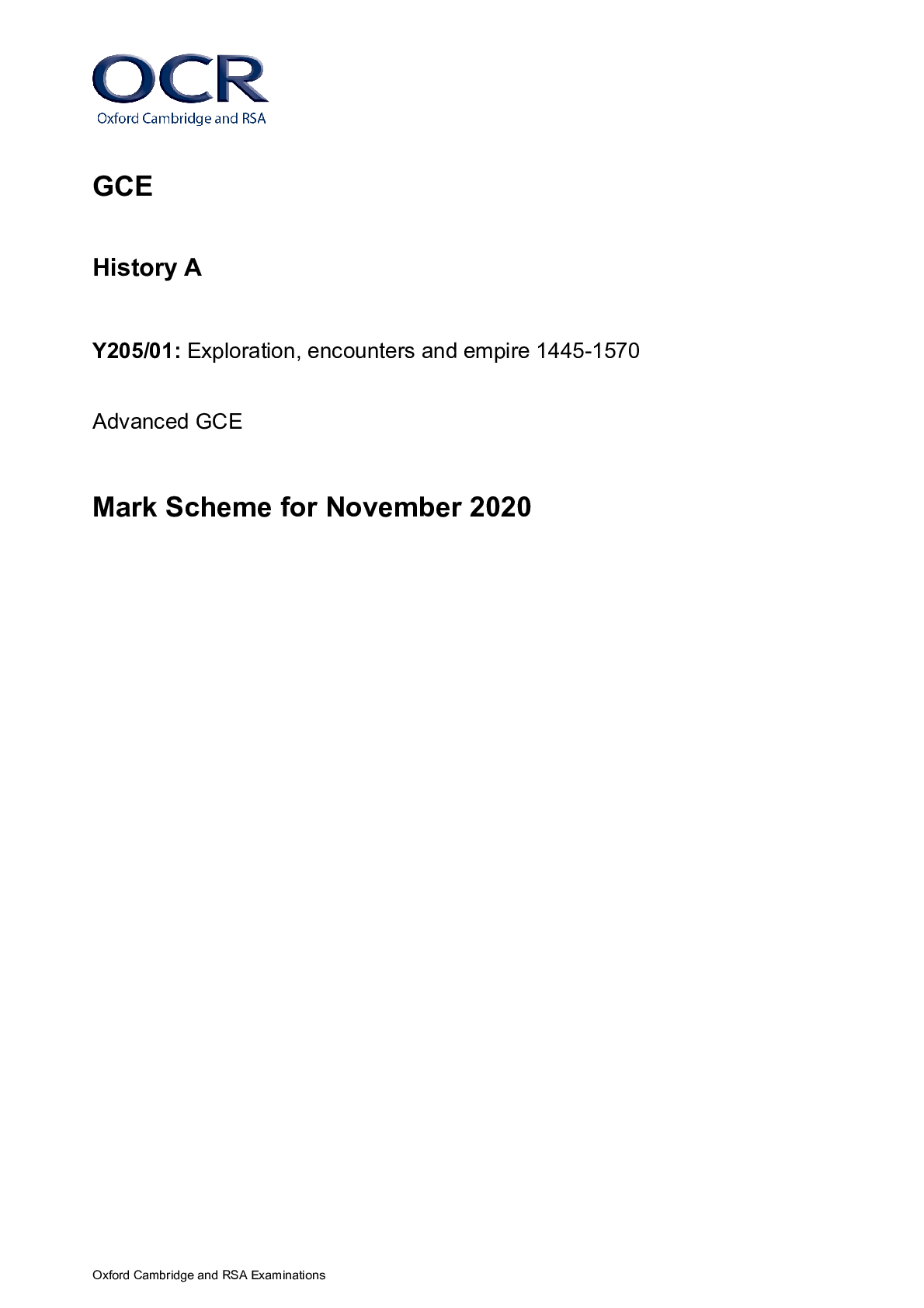
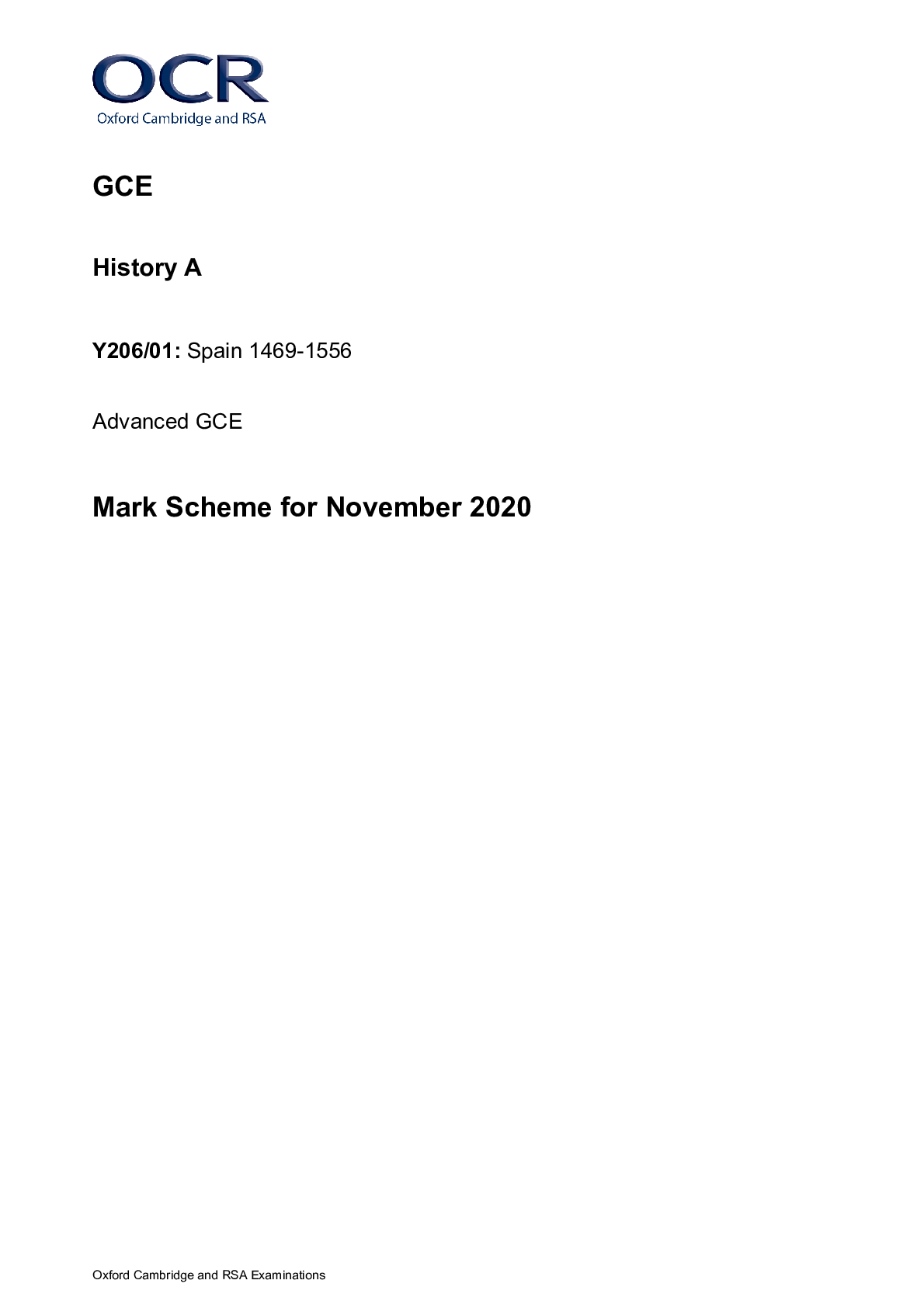
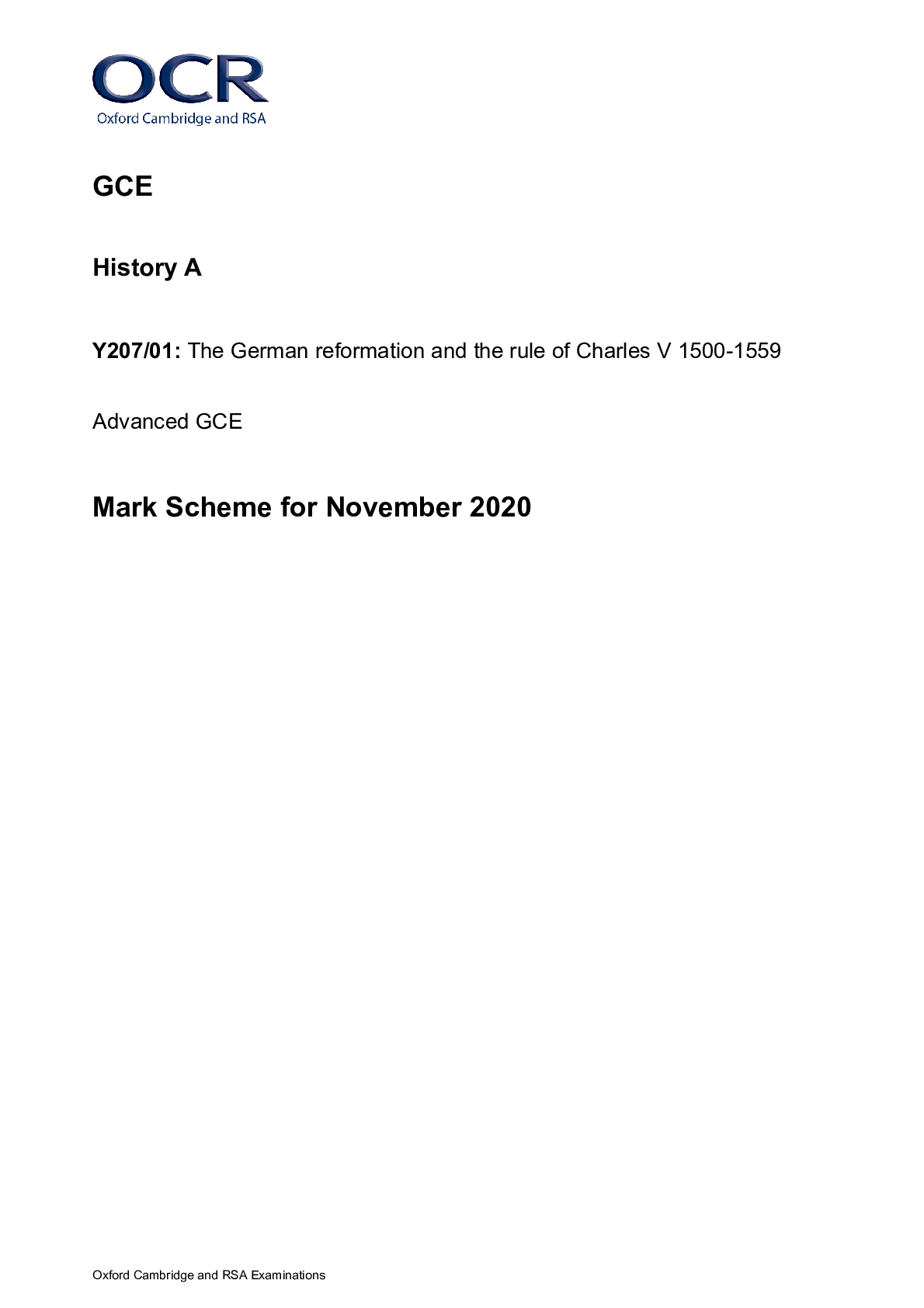
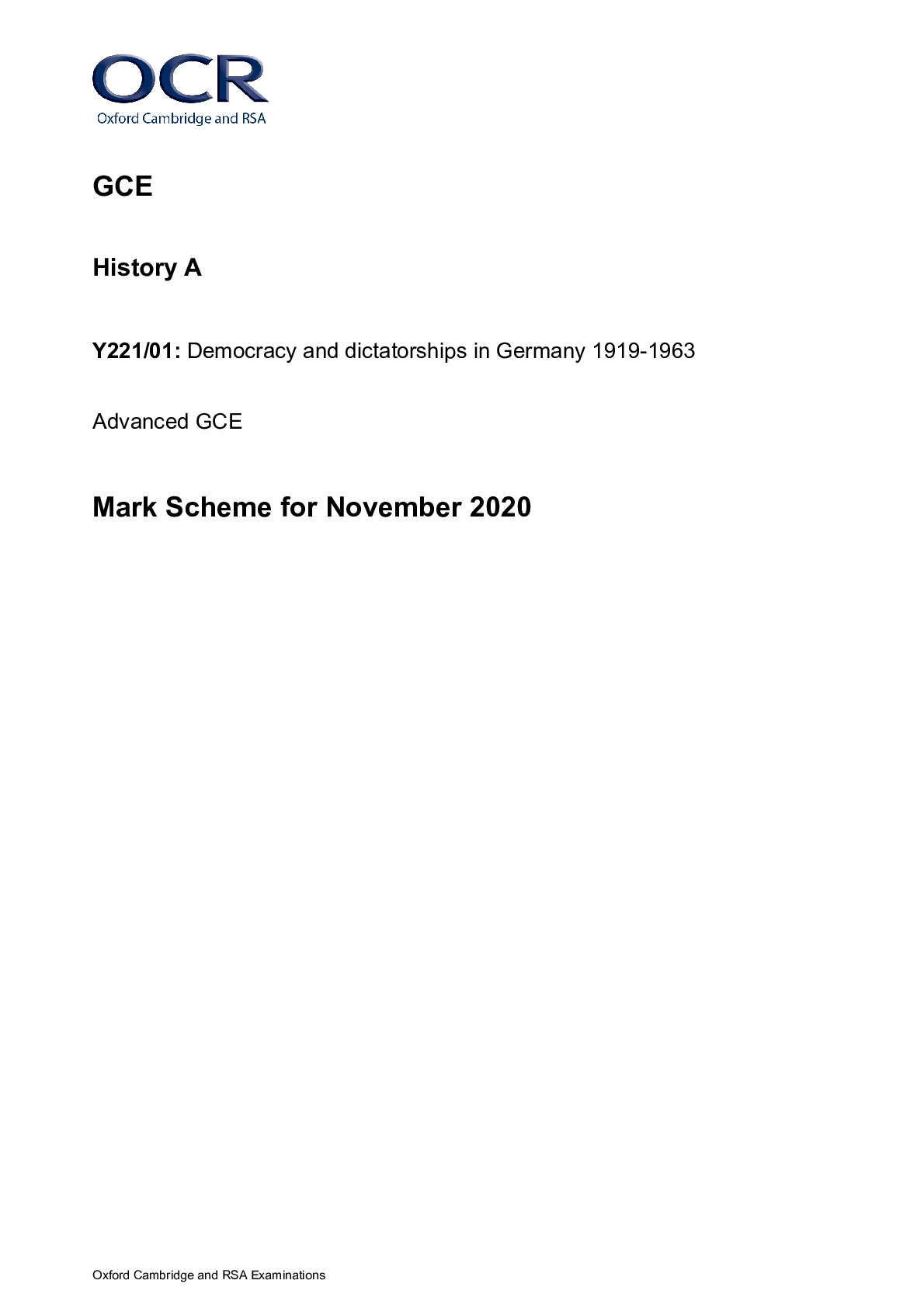

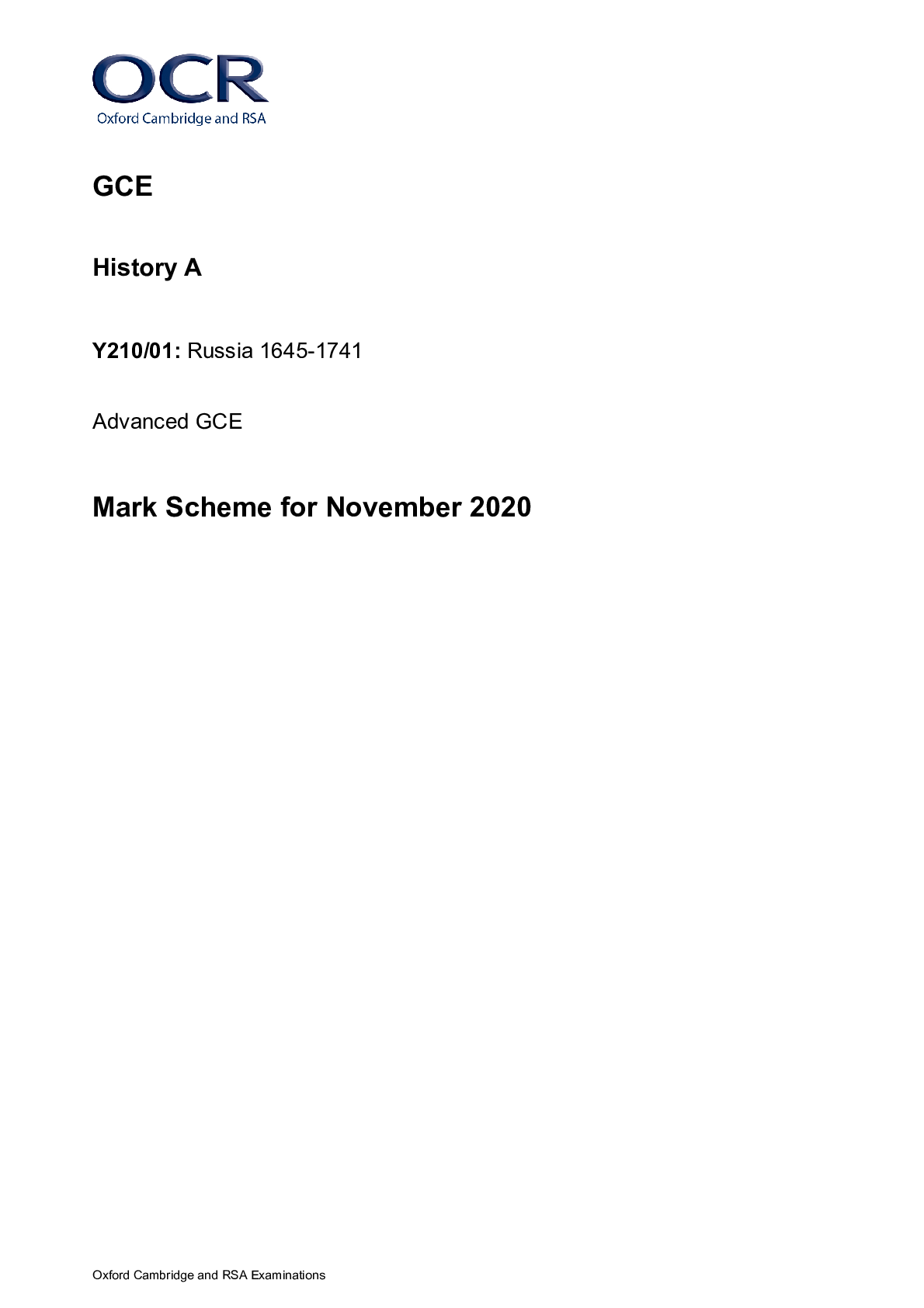


.png)



